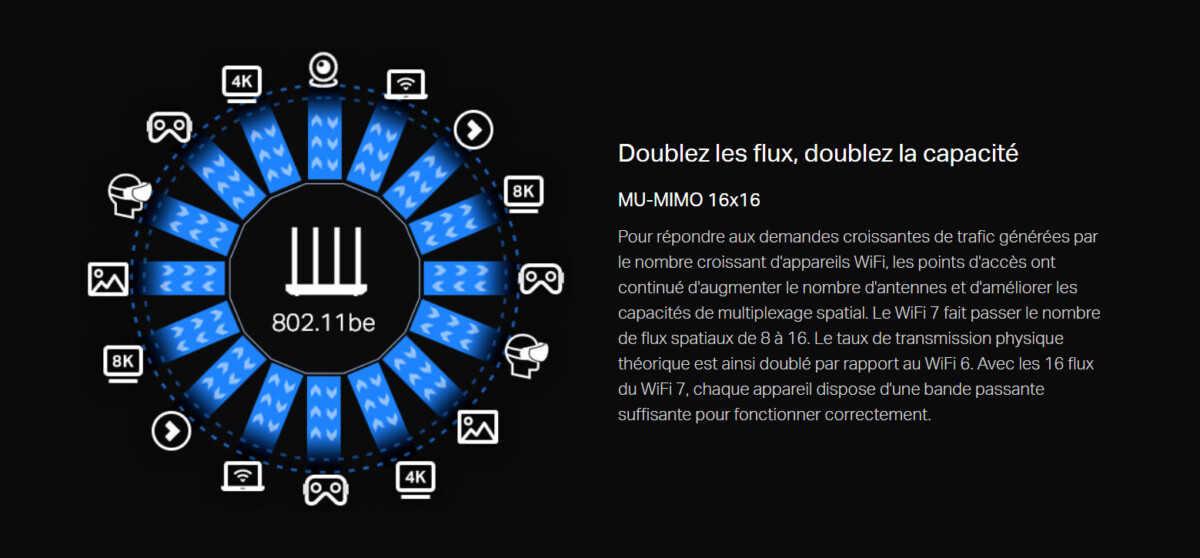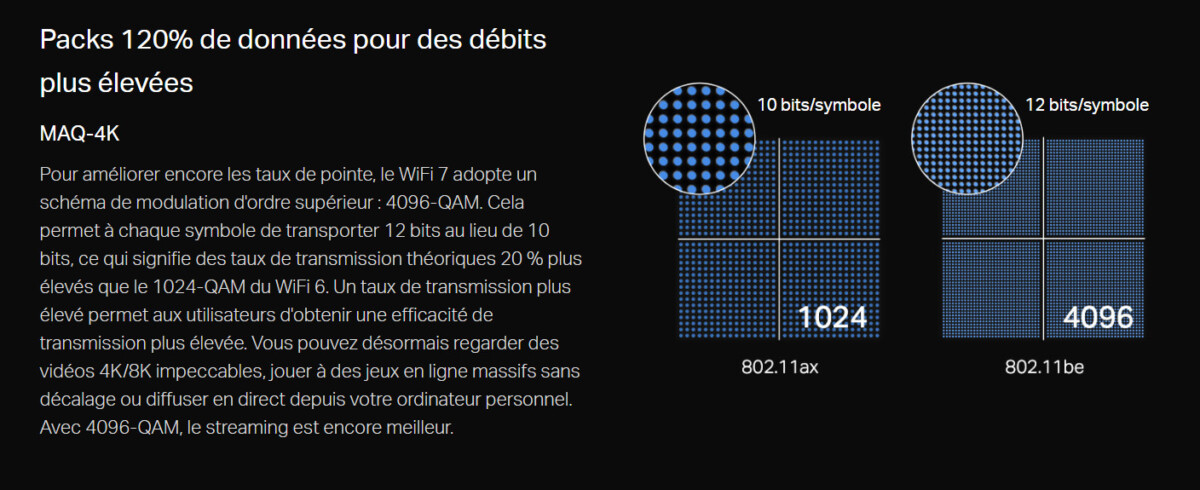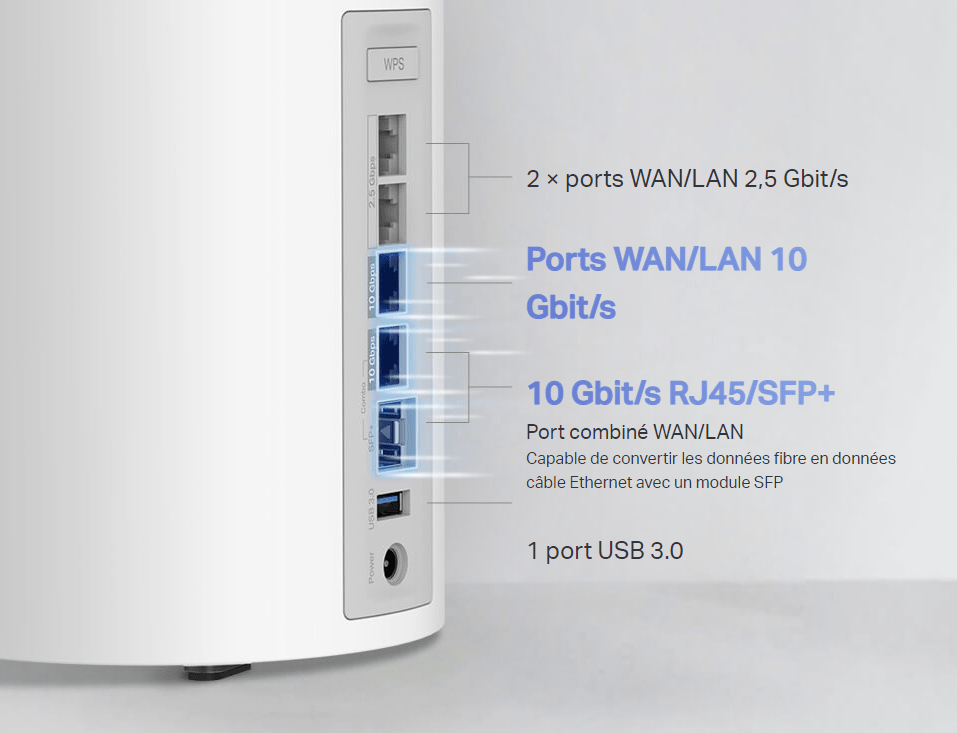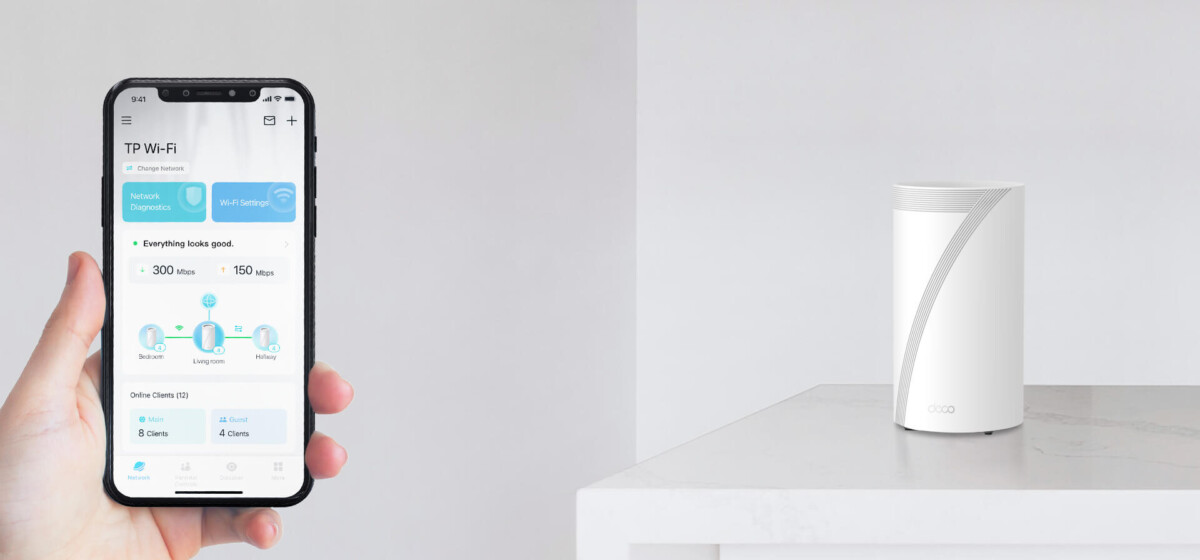Wi-Fi 7 is already here! TP-Link has just launched its first router compatible with the future standard: the TP-Link Deco BE85. The opportunity to take stock of the advances expected for Wi-Fi 7.
Although the Wi-Fi 7 (802.11 be) standard will not be definitively formalized until next year, this does not prevent router manufacturers from already preparing for its arrival. This is the case of TP-Link which today makes its first Wi-Fi 7 router available for pre-order: the Deco BE85. And it is Boulanger who has the scoop.
The Deco BE85 is available individually, but also in a pack comprising two Deco BE85, to set up a Wi-Fi Mesh network.
It is quite simply the fastest and most efficient router released by the brand to date. Not only is it compatible with all old Wi-Fi standards (from good old 802.11a to the latest 802.11ax or Wi-Fi 6E), but it is already compatible with Wi-Fi 7. But, do you really know what Will Bring Wi-Fi 7?
Wi-Fi 7 is for 2024, so why are the first routers here?
The advantage of Wi-Fi is that it is a standard, a standard, established by an organization, the Institute of Electrical and Electronics Engineers or IEEE. A serious organization followed by electronics brands around the world. With each new Wi-Fi standard, the IEEE takes the time (often several years) to reflect on significant and consistent advances that help make Wi-Fi ever faster, more reliable, more secure and more convenient.
The latest standard is Wi-Fi 6E, which dates from 2021. Wi-Fi 7 has been under consideration since 2021 and the standard should be completed by the first quarter of 2024. If the main specifications are today Today, the IEEE still has to finalize the technical details to make it compatible with the devices of tomorrow. In short: we already know what Wi-Fi 7 will be and how it will be transmitted, but not yet fully how future devices and chips will receive it (securely).
| Standard | WiFi 5 | WiFi 6 | WiFi 6E | WiFi 7 |
|---|---|---|---|---|
| Release date | 2013 | 2019 | 2021 | 2024. |
| IEEE standard | 802.11ac | 802.11ax | 802.11ax | 802.11be |
| Maximum data rate | 3.5 Gbps | 9.6 Gbps | 9.6 Gbps | 46 Gbps |
| Bands | 5GHz | 2.4GHz, 5GHz | 2.4GHz, 5GHz, 6GHz | 2.4GHz, 5GHz, 6GHz |
| Channel size | 20, 40, 80, 80+80, 160MHz | 20, 40, 80, 80+80, 160MHz | 20, 40, 80, 80+80, 160MHz | Up to 320MHz |
| Modulation | 256-QAM OFDM | 1024-QAM OFDMA | 1024-QAM OFDMA | 4096-QAM OFDMA Enhanced |
| In debit | 4×4 MIMO DL MIMO | 8×8 UL/DL MU-MIMO | 8×8 UL/DL MU-MIMO | 16×16 UL/DL MU-MIMO |
This explains why the first Wi-Fi 7 routers are already on the market, although there are currently no smartphones or computers capable of receiving them. The arrival of these devices is expected on the market sometime next year, probably after CES 2024.
What are the benefits of Wi-Fi 7
If we had to sum up the advances of Wi-Fi 7 in two words, it would be: speed (speeds) and response time (latency). The official TP-Link website hosts a comprehensive and educational page on the subject.
YouTube linkSubscribe to Frandroid
Maximum throughput of 46 Gbit/s
A number to start with: in terms of maximum throughput, Wi-Fi 7 will be 4.8 times greater than Wi-Fi 6. This goes from a maximum throughput of 9.6 Gbit/s for Wi-Fi 6 to 46 Gbit/s for Wi-Fi 7. This multiplication by 4.8 does not come from nowhere.
It is explained first of all by the doubling of the number of the data flow. Today, Wi-Fi 6 is able to conduct eight data streams simultaneously, which is generally the number of antennas in Wi-Fi routers. There are 16 with Wi-Fi 7.

Added to this is the arrival of a new modulation scheme for Wi-Fi 7, 4096-QAM, 20% more efficient than that of Wi-Fi 6. Concretely (and simplifying a lot), the signal of Wi-Fi Fi 7 will be more “dense” in terms of data transported than that of Wi-Fi 6.

Finally, and this is surely the most interesting new feature of Wi-Fi 7, the channel width is doubled, going from 160 MHz for Wi-Fi 6 to 320 MHz (on the 6 GHz band) for Wi- Fi 7. This simply means that the bandwidth allocated to the signal is doubled.

Do the math now: 2x the data stream, 1.2x the data, and double the bandwidth, or 2 × 1.2 × 2 = 4.8. This is how the maximum speed of Wi-Fi 7 has increased by 4.8 times compared to Wi-Fi 6.
Latency of Wi-Fi 7: the end of Ethernet cables in the line of sight?
If you play video games, you know that a good speed is appreciable to download the 150 GB of the latest call of duty quickly. You also know that it is often not recommended to play on Wi-Fi, because the ping (latency) is often too high to play in good conditions. Good throughput is good, but combined with low latency, it’s even better. This is why it is still recommended to play competitive games with an Ethernet cable.
Wi-Fi 7 introduces three new technologies intended to improve both latency and signal reliability.
On the latency side, this is the MRU (Multiple Resource Unit), a significant evolution of OFDMA, introduced with Wi-Fi 6, which improves latency by 20% compared to Wi-Fi 6.
On the signal reliability side, the arrival of the Punching and MLO (Multi-Link Operations) will allow routers to better distribute the data in the different signals sent by Wi-Fi 7 compatible routers. Concretely, if several devices (smartphones, computers, connected objects) each make requests to the router, the latter will be able to further optimize signal data streams to send as much data as efficiently as possible.

Beyond these significant technological advances, the promise of Wi-Fi 7 is enticing: with ever-lower latency, the dream of finally getting rid of Ethernet cables is closer than ever. The ball is now in the court of the chip designers to know what the actual speeds will give compared to the theoretical speeds.
Deco BE85: the first Wi-Fi 7 router from TP-Link
TP-Link today launches its first Wi-Fi 7 router: the Tp-Link Deco BE85. It is a high-end multi-gigabit, tri-band Wi-Fi Mesh router, and therefore capable of transmitting on the 6 GHz band.
It boasts an elegant cylinder-shaped design. It is also a router that knows how to be discreet with dimensions of only 128 × 128 × 236 mm.
The TP-Link Deco BE85 Wi-Fi 7 Router
The Deco BE85 has 4 Ethernet ports with 2 x 10 Gbit/s and 2 x 2.5 Gbit/s ports as well as a USB 3.0 port for connection to FTP servers, Media servers, Samba servers or Time Machines. Thanks to its 8 internal antennas, it broadcasts its signal on 12 channels and can communicate with more devices simultaneously thanks to 4×4 MU-MIMO.

TP-Link obliges, this router benefits from TP-Link HomeShield, a complete network protection solution with a parental control system and a complete and ergonomic mobile application to configure and administer the router. Finally, it is possible to install several Deco BE85 in the same installation in order to create a high-performance Mesh network in your home or business.

The Deco BE85 is also sold in a pack comprising two devices to set up a Wi-Fi Mesh network.
